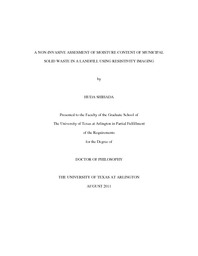| dc.description.abstract | A bioreactor landfill is operated to enhance waste decomposition, gas production, and refuse stabilization. The fundamental aspect in the operation of a bioreactor landfill is the controlled addition of water and/or the recirculation of leachate into the landfill's waste mass. Since there is an increasing trend to operate landfills as bioreactor landfills, it is crucial to understand the moisture distribution within the landfill. Monitoring the moisture distribution within a bioreactor landfill is essential not only for the design and operation of leachate recirculation systems, but also to identify sites with non-uniform leachate distribution due to ponding and channeling.In the recent years, there has been a huge interest in using electrical resistivity imaging (ERI) as a non-destructive tool to monitor the moisture distribution within a bioreactor landfill. ERI can detect variation in moisture content, because along with other factors, resistivity varies with moisture content. ERI can produce detailed profiles of the subsurface, showing the spatial distribution of moisture within the landfill. However, these profiles do not give quantitative information about the moisture content of the waste. The overall objective of this research is to develop a correlation between electrical resistivity and moisture content of waste, in order to be able to determine in situ moisture content of municipal solid waste (MSW) without any direct sampling and laboratory testing. Since electrical resistivity depends on several factors, an experimental program was developed to study the variation of electrical resistivity of MSW with moisture content, unit weight, stage of decomposition, temperature, composition of MSW, and composition of pore fluid. Fresh, landfilled, and degraded MSW samples were used for this study. Fresh and landfilled MSW samples were collected from the City of Denton landfill. Degraded MSW samples were prepared using laboratory scale reactors.Laboratory results showed that resistivity is a complex property that depends on numerous factors. A trend of decreasing electrical resistivity with increasing moisture content was observed. For example, the resistivity of fresh MSW sample #1 decreased from 21.6 ohm-m at moisture content of 21.4% to 2.4 ohm-m at moisture content of 52.6%. Results showed that resistivity depends on unit weight. A trend of decreasing resistivity with increasing unit weight was observed. For example, the resistivity of fresh MSW sample #1 decreased from 21.6 ohm-m at unit weight of 35 lb/ft3 to 14.9 ohm-m at unit weight of 55 lb/ft3. Resistivity tests on decomposed MSW samples prepared in laboratory scale reactors indicated that electrical resistivity decreased with decomposition. Resistivity decreased from 8.98 ohm-m in phase 1 to 4.91 ohm-m in phase 4. This decrease in is most probably caused by the increase in unit weight as a result of decomposition. Results also showed that electrical resistivity of MSW decreases with increasing temperature. The resistivity of MSW decreased by about 2% per temperature increase of 1°C. MSW samples having same moisture content and same unit weight had different resistivity values, indicating that the composition of the waste itself affects resistivity. A decrease in electrical resistivity with increasing paper content was observed. On the other hand, an increase in electrical resistivity with increasing "others" (soil and fines) content was observed. Based on the experimental results, the effect of the pore fluid composition on the resistivity of MSW is not significant. Same MSW samples had almost identical resistivity values when prepared using tap water, leachate, or re-use water. Multiple linear regression analysis was used to quantify the effect of the several factors that affect resistivity. Five predictor variables were considered: moisture content, unit weight, percentage paper, percentage "others" (fines), and organic content. The best model was selected using backward elimination method, best subsets selection method, and stepwise regression method. The developed model was validated using a second set of landfilled MSW samples. ERI was conducted at the same location from which the MSW samples were collected. Using the field resistivity values and the developed model, the moisture content was estimated. The estimated moisture content was then compared with the actual moisture content determined by oven drying the samples at the laboratory. Good agreement was found between the estimated moisture contents and the measured values. The percentage error ranged from 4.9 to 10.2 percent and from 0.5 to 13.8 percent for MSW samples from boreholes B70 and B72, respectively. | en_US |


